driver seat adjustment Seat Cordoba 2007 Owner's Manual
[x] Cancel search | Manufacturer: SEAT, Model Year: 2007, Model line: Cordoba, Model: Seat Cordoba 2007Pages: 256, PDF Size: 7.75 MB
Page 8 of 256
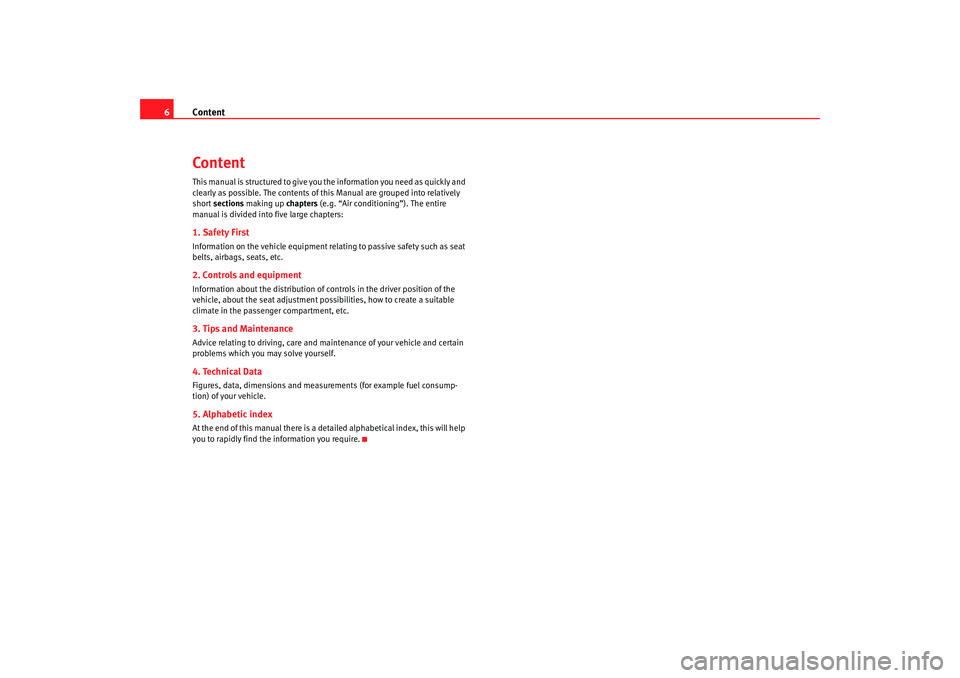
Content
6ContentThis manual is structured to give you the information you need as quickly and
clearly as possible. The contents of t his Manual are grouped into relatively
short sections making up chapters (e.g. “Air conditioning”). The entire
manual is divided into five large chapters:1. Safety FirstInformation on the vehicle equipment relating to passive safety such as seat
belts, airbags, seats, etc.2. Controls and equipmentInformation about the distribution of co ntrols in the driver position of the
vehicle, about the seat adjustment possibilities, how to create a suitable
climate in the passenger compartment, etc.3. Tips and MaintenanceAdvice relating to driving, care and ma intenance of your vehicle and certain
problems which you may solve yourself.4. Technical DataFigures, data, dimensions and measurements (for example fuel consump-
tion) of your vehicle.5. Alphabetic indexAt the end of this manual there is a detailed alphabetical index, this will help
you to rapidly find the information you require.
cordoba_ingles_0706 Seite 6 Montag, 28. August 2006 1:18 13
Page 11 of 256
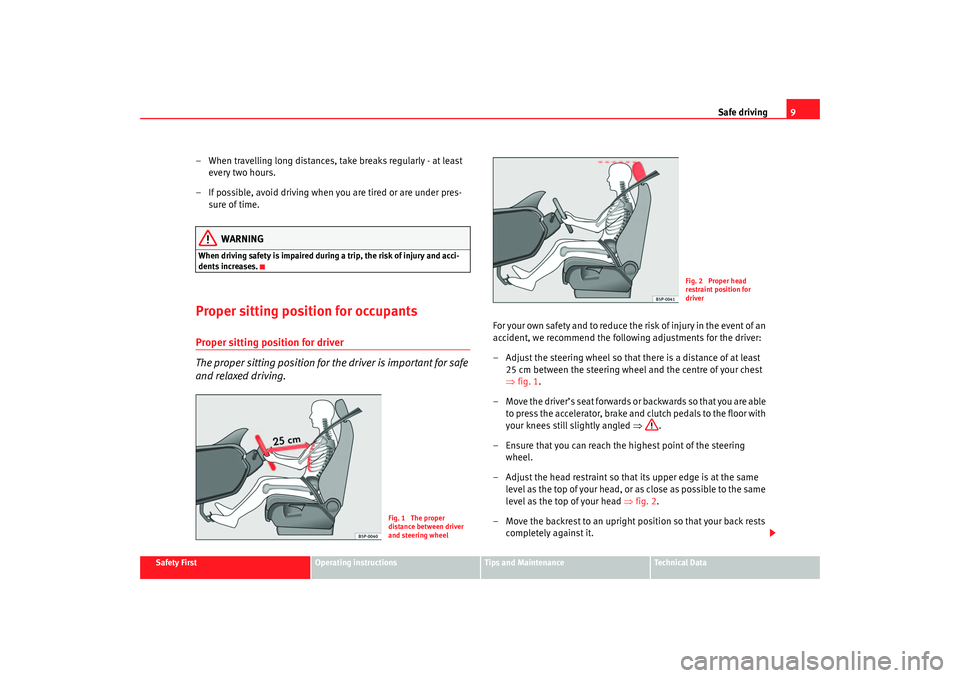
Safe driving9
Safety First
Operating instructions
Tips and Maintenance
Te c h n i c a l D a t a
– When travelling long distances, take breaks regularly - at least
every two hours.
– If possible, avoid driving when you are tired or are under pres- sure of time.
WARNING
When driving safety is impaired during a trip, the risk of injury and acci-
dents increases.Proper sitting position for occupantsProper sitting position for driver
The proper sitting position for the driver is important for safe
and relaxed driving.
For your own safety and to reduce the risk of injury in the event of an
accident, we recommend the following adjustments for the driver:
– Adjust the steering wheel so that there is a distance of at least
25 cm between the steering wheel and the centre of your chest
⇒ fig. 1.
– Move the driver’s seat forwards or backwards so that you are able to press the accelerator, brake and clutch pedals to the floor with
your knees still slightly angled ⇒.
– Ensure that you can reach the highest point of the steering wheel.
– Adjust the head restraint so that its upper edge is at the same level as the top of your head, or as close as possible to the same
level as the top of your head ⇒fig. 2.
– Move the backrest to an upright position so that your back rests completely against it.
Fig. 1 The proper
distance between driver
and steering wheel
Fig. 2 Proper head
restraint position for
driver
cordoba_ingles_0706 Seite 9 Montag, 28. August 2006 1:18 13
Page 12 of 256
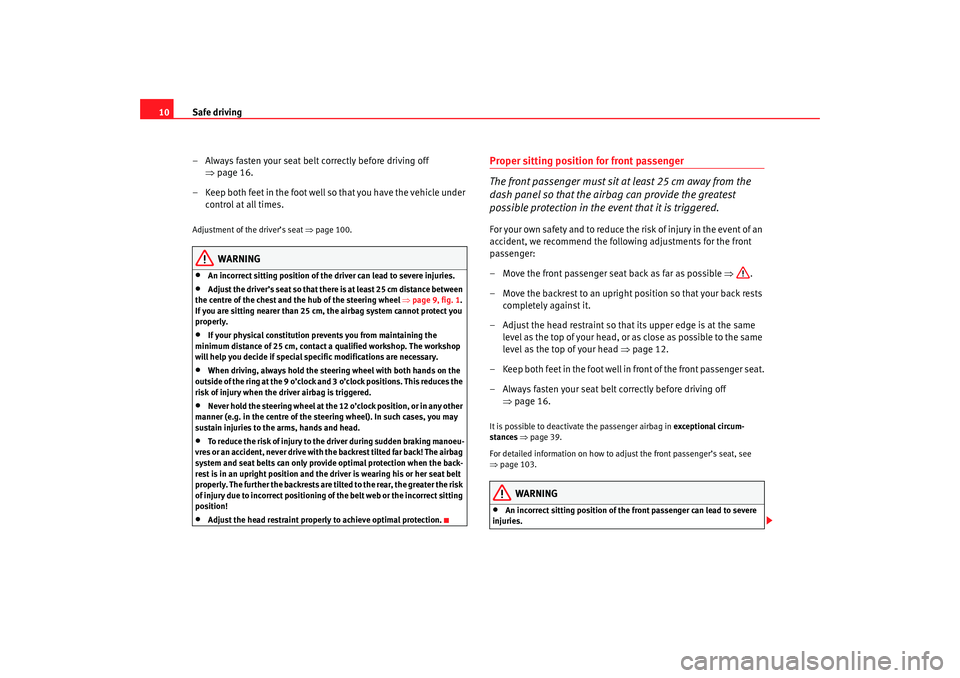
Safe driving
10
– Always fasten your seat belt correctly before driving off ⇒page 16.
– Keep both feet in the foot well so that you have the vehicle under control at all times.Adjustment of the driver’s seat ⇒page 100.
WARNING
•
An incorrect sitting position of the driver can lead to severe injuries.
•
Adjust the driver’s seat so that th ere is at least 25 cm distance between
the centre of the chest and the hub of the steering wheel ⇒page 9, fig. 1 .
If you are sitting nearer than 25 cm, the airbag system cannot protect you
properly.
•
If your physical constitution prevents you from maintaining the
minimum distance of 25 cm, contact a qualified workshop. The workshop
will help you decide if special specific modifications are necessary.
•
When driving, always hold the steer ing wheel with both hands on the
outside of the ring at the 9 o’clock and 3 o’clock positions. This reduces the
risk of injury when the driver airbag is triggered.
•
Never hold the steering wheel at the 12 o’clock position, or in any other
manner (e.g. in the centre of the stee ring wheel). In such cases, you may
sustain injuries to the arms, hands and head.
•
To reduce the risk of injury to the driver during sudden braking manoeu-
vres or an accident, never drive with the backrest tilted far back! The airbag
system and seat belts can only provide optimal protection when the back-
rest is in an upright position and the dr iver is wearing his or her seat belt
properly. The further the backrests are ti lted to the rear, the greater the risk
of injury due to incorrect positioning of the belt web or the incorrect sitting
position!
•
Adjust the head restraint properly to achieve optimal protection.
Proper sitting position for front passenger
The front passenger must sit at least 25 cm away from the
dash panel so that the airbag can provide the greatest
possible protection in the event that it is triggered.For your own safety and to reduce the risk of injur y in the event of an
accident, we recommend the following adjustments for the front
passenger:
– Move the front passenger seat back as far as possible ⇒.
– Move the backrest to an upright position so that your back rests completely against it.
– Adjust the head restraint so that its upper edge is at the same level as the top of your head, or as close as possible to the same
level as the top of your head ⇒page 12.
– Keep both feet in the foot well in front of the front passenger seat.
– Always fasten your seat belt correctly before driving off ⇒page 16.It is possible to deactivate the passenger airbag in exceptional circum-
stances ⇒page 39.
For detailed information on how to adjust the front passenger’s seat, see
⇒ page 103.
WARNING
•
An incorrect sitting position of the front passenger can lead to severe
injuries.
cordoba_ingles_0706 Seite 10 Montag, 28. August 2006 1:18 13
Page 15 of 256
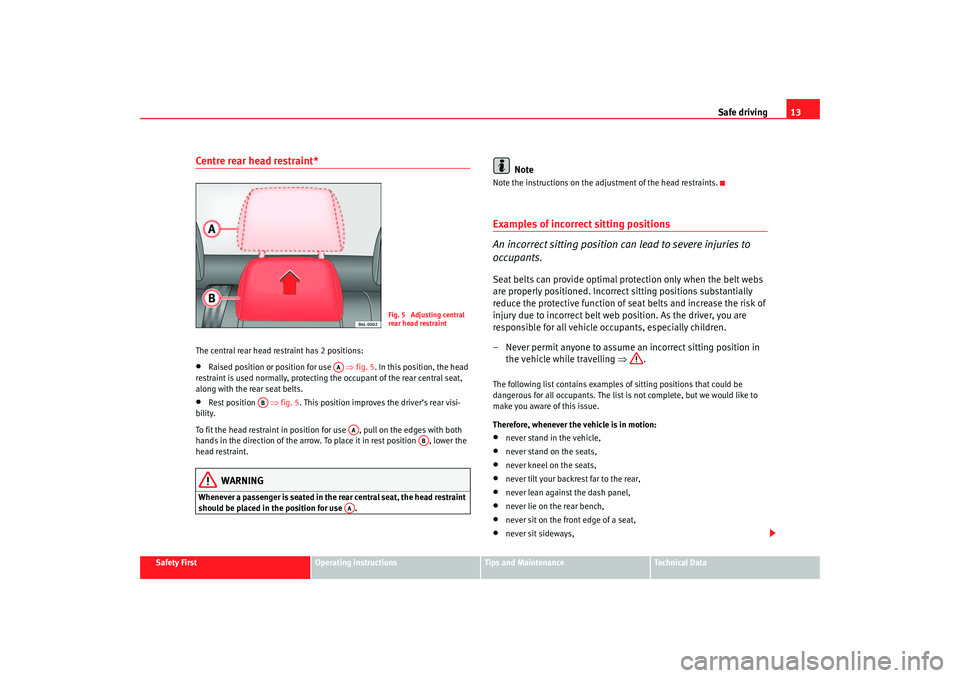
Safe driving13
Safety First
Operating instructions
Tips and Maintenance
Te c h n i c a l D a t a
Centre rear head restraint*The central rear head restraint has 2 positions:•
Raised position or position for use ⇒fig. 5 . In this position, the head
restraint is used normally, protecting the occupant of the rear central seat,
along with the rear seat belts.
•
Rest position ⇒fig. 5 . This position improves the driver’s rear visi-
bility.
To fit the head restraint in position for use , pull on the edges with both
hands in the direction of the arrow. To place it in rest position , lower the
head restraint.
WARNING
Whenever a passenger is seated in the rear central seat, the head restraint
should be placed in the position for use .
Note
Note the instructions on the adjustment of the head restraints.Examples of incorrect sitting positions
An incorrect sitting position can lead to severe injuries to
occupants.Seat belts can provide optimal protection only when the belt webs
are properly positioned. Incorrec t sitting positions substantially
reduce the protective function of se at belts and increase the risk of
injury due to incorrect belt web position. As the driver, you are
responsible for all vehicle occupants, especially children.
– Never permit anyone to assume an incorrect sitting position in the vehicle while travelling ⇒ .The following list contains examples of sitting positions that could be
dangerous for all occupants. The list is not complete, but we would like to
make you aware of this issue.
Therefore, whenever the vehicle is in motion:• never stand in the vehicle,•
never stand on the seats,
•
never kneel on the seats,
•
never tilt your backrest far to the rear,
•
never lean against the dash panel,
•
never lie on the rear bench,
•
never sit on the front edge of a seat,
•
never sit sideways,
Fig. 5 Adjusting central
rear head restraint
AA
AB
AA
AB
AA
cordoba_ingles_0706 Seite 13 Montag, 28. August 2006 1:18 13
Page 102 of 256
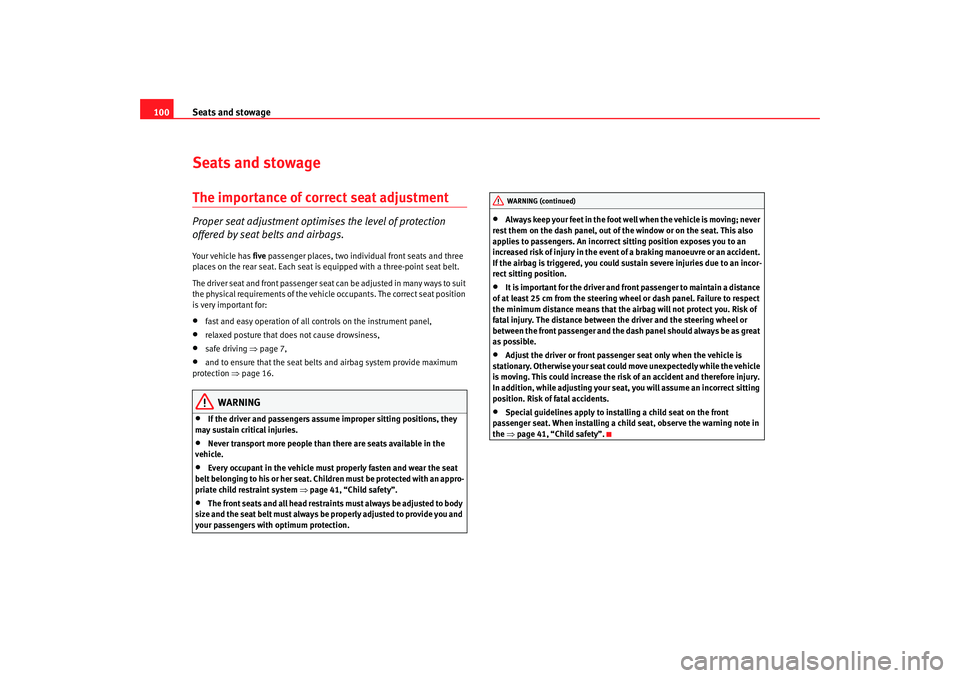
Seats and stowage
100Seats and stowageThe importance of correct seat adjustmentProper seat adjustment optimi ses the level of protection
offered by seat belts and airbags.Your vehicle has five passenger places, two individual front seats and three
places on the rear seat. Each seat is equipped with a three-point seat belt.
The driver seat and front passenger seat can be adjusted in many ways to suit
the physical requirements of the vehicl e occupants. The correct seat position
is very important for:•
fast and easy operation of all controls on the instrument panel,
•
relaxed posture that does not cause drowsiness,
•
safe driving ⇒page 7,
•
and to ensure that the seat belts and airbag system provide maximum
protection ⇒page 16.
WARNING
•
If the driver and passengers assume improper sitting positions, they
may sustain critical injuries.
•
Never transport more people than there are seats available in the
vehicle.
•
Every occupant in the vehicle must properly fasten and wear the seat
belt belonging to his or her seat. Children must be protected with an appro-
priate child restraint system ⇒page 41, “Child safety”.
•
The front seats and all head restraints must always be adjusted to body
size and the seat belt must always be properly adjusted to provide you and
your passengers with optimum protection.
•
Always keep your feet in the foot well when the vehicle is moving; never
rest them on the dash panel, out of the window or on the seat. This also
applies to passengers. An incorrect sitting position exposes you to an
increased risk of injury in the event of a braking manoeuvre or an accident.
If the airbag is triggered, you could sustain severe injuries due to an incor-
rect sitting position.
•
It is important for the driver and front passenger to maintain a distance
of at least 25 cm from the steering wh eel or dash panel. Failure to respect
the minimum distance means that the airbag will not protect you. Risk of
fatal injury. The distance between the driver and the steering wheel or
between the front passenger and the dash panel should always be as great
as possible.
•
Adjust the driver or front passenger seat only when the vehicle is
stationary. Otherwise your seat could move unexpectedly while the vehicle
is moving. This could increase the risk of an accident and therefore injury.
In addition, while adjusting your seat, you will assume an incorrect sitting
position. Risk of fatal accidents.
•
Special guidelines apply to installing a child seat on the front
passenger seat. When installing a chil d seat, observe the warning note in
the ⇒page 41, “Child safety”.WARNING (continued)
cordoba_ingles_0706 Seite 100 Montag, 28. August 2006 1:18 13
Page 127 of 256
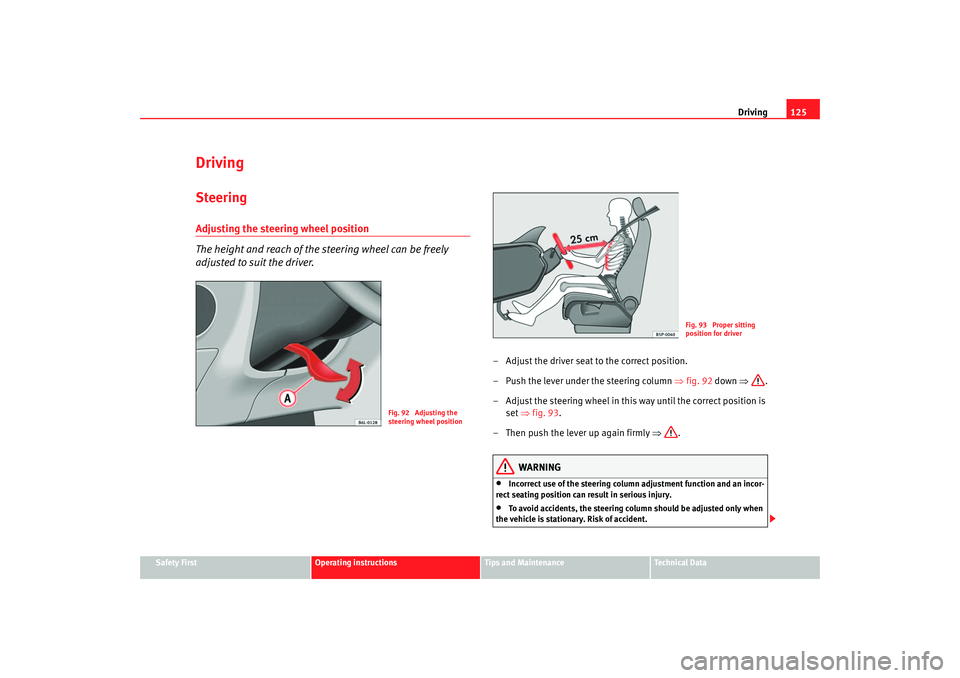
Driving125
Safety First
Operating instructions
Tips and Maintenance
Te c h n i c a l D a t a
DrivingSteeringAdjusting the steering wheel position
The height and reach of the steering wheel can be freely
adjusted to suit the driver.
– Adjust the driver seat to the correct position.
– Push the lever under the steering column ⇒fig. 92 down ⇒ .
– Adjust the steering wheel in this way until the correct position is set ⇒fig. 93 .
– Then push the lever up again firmly ⇒.
WARNING
•
Incorrect use of the steering column adjustment function and an incor-
rect seating position can result in serious injury.
•
To avoid accidents, the steering column should be adjusted only when
the vehicle is stationary. Risk of accident.
Fig. 92 Adjusting the
steering wheel position
Fig. 93 Proper sitting
position for driver
cordoba_ingles_0706 Seite 125 Montag, 28. August 2006 1:18 13
Page 252 of 256

Index
250Roll-back function
Sliding/tilting roof . . . . . . . . . . . . . . . . . . . . 86
Windows . . . . . . . . . . . . . . . . . . . . . . . . . . . . 84
Roof aerial* . . . . . . . . . . . . . . . . . . . . . . . . . . . . 166
Roof carrier* . . . . . . . . . . . . . . . . . . . . . . . . . . . . 113
Rubber seals . . . . . . . . . . . . . . . . . . . . . . . . . . . 160
Running-in Brake pads . . . . . . . . . . . . . . . . . . . . . . . . . . 145
Engine . . . . . . . . . . . . . . . . . . . . . . . . . . . . . 145
Tyres . . . . . . . . . . . . . . . . . . . . . . . . . . . . . . . 145
Running-in tyres . . . . . . . . . . . . . . . . . . . . . . . . 145SSafe driving . . . . . . . . . . . . . . . . . . . . . . . . . . . . . . 7
Safety . . . . . . . . . . . . . . . . . . . . . . . . . . . . . . . . . . . 8
Safety equipment . . . . . . . . . . . . . . . . . . . . . . . . . 7
Safety instructions Coolant temperature . . . . . . . . . . . . . . . . . . . 62
Safety notes Belt tension devices . . . . . . . . . . . . . . . . . . . 25
Curtain airbags . . . . . . . . . . . . . . . . . . . . . . . 37
Disabling front passenger airbag . . . . . . . . 40
Front airbags . . . . . . . . . . . . . . . . . . . . . . . . . 32
Side airbags . . . . . . . . . . . . . . . . . . . . . . . . . 35
Using child seats . . . . . . . . . . . . . . . . . . . . . . 41
Using seat belts . . . . . . . . . . . . . . . . . . . . . . 20
Safety system- safe . . . . . . . . . . . . . . . . . . . . . . . 69
Seals . . . . . . . . . . . . . . . . . . . . . . . . . . . . . . . . . 160
Seat adjustment . . . . . . . . . . . . . . . . . . . . 100, 103 Seat belt position
Pregnant women . . . . . . . . . . . . . . . . . . . . . . 23
Seat belts . . . . . . . . . . . . . . . . . . . . . . . . . . . . 22
Seat belt release . . . . . . . . . . . . . . . . . . . . . . . . . 24
Seat belt warning lamp . . . . . . . . . . . . . . . . . . . . 16
Seat belts . . . . . . . . . . . . . . . . . . . . . . . . . . . . . . . 16 adjustment . . . . . . . . . . . . . . . . . . . . . . . . . . 21
Incorrectly fastened . . . . . . . . . . . . . . . . . . . 24
Not worn . . . . . . . . . . . . . . . . . . . . . . . . . . . . 19
Safety notes . . . . . . . . . . . . . . . . . . . . . . . . . . 20
Warning lamp . . . . . . . . . . . . . . . . . . . . . . . . 16
Seat belts protect . . . . . . . . . . . . . . . . . . . . . . . . 20
Seat heating . . . . . . . . . . . . . . . . . . . . . . . . . . . 104
Seats . . . . . . . . . . . . . . . . . . . . . . . . . . . . . . . . . . 16
Selective opening* . . . . . . . . . . . . . . . . . . . . . . . 70
Semiautomatic air conditioning controls . . . . . . . . . . . . . . . . . . . . . . . . . . . . 117
Shoes . . . . . . . . . . . . . . . . . . . . . . . . . . . . . . . . . . 14
Side airbags . . . . . . . . . . . . . . . . . . . . . . . . . . . . 32 Description . . . . . . . . . . . . . . . . . . . . . . . . . . 32
Function . . . . . . . . . . . . . . . . . . . . . . . . . . . . . 34
Safety notes . . . . . . . . . . . . . . . . . . . . . . . . . . 35
Side lights . . . . . . . . . . . . . . . . . . . . . . . . . . . . . . 87
Sitting position Driver . . . . . . . . . . . . . . . . . . . . . . . . . . . . . . . . 9
Front passenger . . . . . . . . . . . . . . . . . . . . . . 10
Incorrect sitting position . . . . . . . . . . . . . . . 13
Passengers . . . . . . . . . . . . . . . . . . . . . . . . . . 11
Sitting position, occupants . . . . . . . . . . . . . . . . . 9
Sliding/tilting roof . . . . . . . . . . . . . . . . . . . . . . . 85
Snow chains . . . . . . . . . . . . . . . . . . . . . . . 192, 229 Soot accumulation in the
diesel engine particulate
filter *
Indicator . . . . . . . . . . . . . . . . . . . . . . . . . . . . 64
Spare wheel* . . . . . . . . . . . . . . . . . . . . . . . . . . . 193
Speedometer . . . . . . . . . . . . . . . . . . . . . . . . . . . . 52
Starting Petrol engines . . . . . . . . . . . . . . . . . . . 129
Starting the engine . . . . . . . . . . . . . . . . . . 128, 129 After the fuel tank has been run dry . . . . . 130
Steam cleaners . . . . . . . . . . . . . . . . . . . . . . . . . 158
Steering . . . . . . . . . . . . . . . . . . . . . . . . . . . . . . . 125 Steering lock . . . . . . . . . . . . . . . . . . . . . . . . 127
Steering wheel controls . . . . . . . . . . . . . . . . . . . 66
Steering wheel height adjustment . . . . . . . . . 125
Stowage frnt right seats . . . . . . . . . . . . . . . . . . . . . . . 107
Stowage compartment Front passenger side . . . . . . . . . . . . . . . . . 106
Sun visors . . . . . . . . . . . . . . . . . . . . . . . . . . . . . . 93
Sunroof . . . . . . . . . . . . . . . . . . . . . . . . . . . . . . . . 85
Sunroof blind Sliding/tilting roof . . . . . . . . . . . . . . . . . . . . 85
Switch Hazard warning lights . . . . . . . . . . . . . . . . . . 89
Rear window heating . . . . . . . . . . . . . . . . . . 88
Switches electric windows . . . . . . . . . . . . . . . . . . . . . . 82
Sliding/tilting roof . . . . . . . . . . . . . . . . . . . . 85
Switching off the engine . . . . . . . . . . . . . . . . . 130
cordoba_ingles_0706 Seite 250 Montag, 28. August 2006 1:18 13